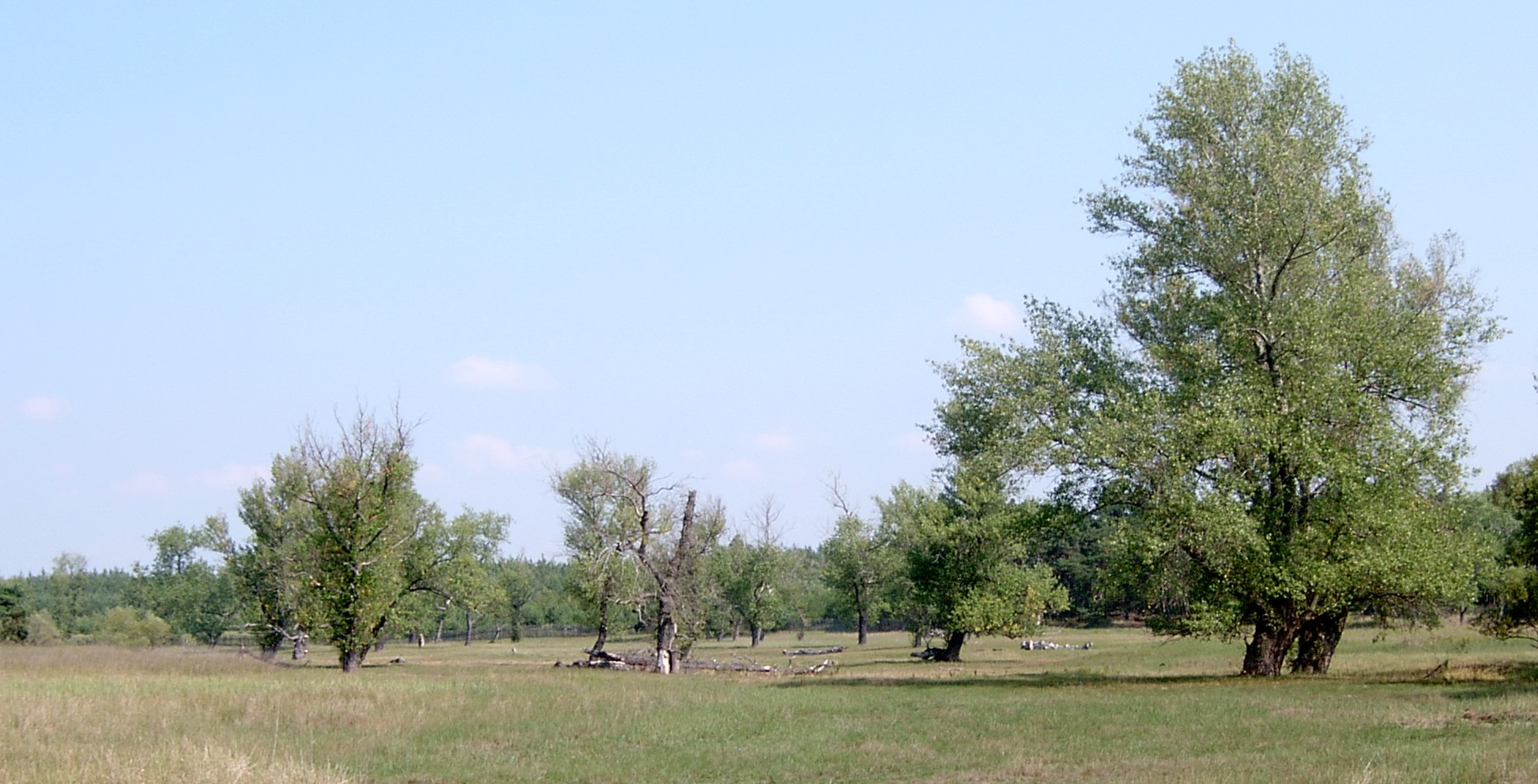- Black Poplar
image_width = 240px
image_caption = Black poplars in Poland
regnum =Plant ae
divisio =Magnoliophyta
classis =Magnoliopsida
ordo =Malpighiales
familia =Salicaceae
genus = "Populus"
sectio = "Aegiros"
species = "P. nigra"
binomial = "Populus nigra"
binomial_authority = L.Black poplar ("Populus nigra") is a
species ofpoplar in thecottonwood ("Aegiros") section of the genus "Populus", native toEurope , southwest and centralAsia , and northwestAfrica .Flora Europaea: [http://rbg-web2.rbge.org.uk/cgi-bin/nph-readbtree.pl/feout?FAMILY_XREF=&GENUS_XREF=Populus+&SPECIES_XREF=nigra&TAXON_NAME_XREF=&RANK= "Populus nigra"] ]It is a medium-sized to large
deciduous tree , reaching 20-30 m (rarely 40 m) tall, with a trunk up to 1.5 m diameter. The leaves are diamond-shaped to triangular, 5-8 cm long and 6-8 cm broad, green on both surfaces.Rushforth, K. (1999). "Trees of Britain and Europe". Collins ISBN 0-00-220013-9.] The species is dioecious (male and female flowers on different plants), with flowers incatkin s andpollination by wind.There are threesubspecies , some botanists distinguishing a fourth:
*"Populus nigra" subsp. "nigra". Central and eastern Europe. Leaves and shoots glabrous (hairless); bark grey-brown, thick and furrowed.
*"Populus nigra" subsp. "betulifolia" (Pursh) W.Wettst. North-west Europe (France ,Great Britain ,Ireland ). Leaf veins and shoots finely downy; bark grey-brown, thick and furrowed, often with heavy burrs, trunk usually heavily leaning.
*"Populus nigra" subsp. "caudina" (Ten.) Bugała. Mediterranean region, also southwest Asia if var. "afghanica" not distinguished.
*"Populus nigra" var. "afghanica" Aitch. & Hemsl. (syn. "P. nigra" var. "thevestina" (Dode) Bean). Southwest Asia; treated as acultivar of "P. nigra" by many botanists,Germplasm Resources Information Network: [http://www.ars-grin.gov/cgi-bin/npgs/html/taxon.pl?29405 "Populus nigra" var. "thevestina"] ] and as a distinct species "P. afghanica" by others;Flora of Pakistan: [http://www.efloras.org/florataxon.aspx?flora_id=5&taxon_id=200005640 "Populus afghanica"] ] bark smooth, nearly white; leaves and shoots as subsp. "caudina" (see also cultivars, below).The subspecies "betulifolia" is one of the rarest trees in
Great Britain andIreland [Milne-Redhead, E. (1990). The B.S.B.I. Black Poplar survey, 1973-88. "Watsonia" 18: 1-5. Available [http://www.watsonia.org.uk/Wats18p1.pdf online] (pdf file).] [Arkive: [http://www.arkive.org/species/ARK/plants_and_algae/Populus_nigra/ "Populus nigra"] ] , with only about 7,000 trees known, of which only about 600 have been confirmed as female [Cooper, Fiona (2006). "The Black Poplar: Ecology, History and Conservation". Windgather Press ISBN 1-905119-05-4] .Several
cultivar s have also been selected, these being propagated readily by cuttings:
*'Italica'. The true Lombardy poplar, selected inLombardy , northernItaly , in the 17th century. The growth is fastigiate, with a very narrow crown. Coming from theMediterranean region, it is adapted to hot, dry summers and grows poorly in humid conditions, being short-lived due to fungal diseases. It is a male clone.Bean, W. J. (1980). "Trees and Shrubs Hardy in the British Isles" Vol. 3. John Murray ISBN 0-7195-2427-X]
*"Plantierensis" group. A group of clones derived by crossing 'Italica' with "P. nigra" ssp "betulifolia" at the Plantières Nursery nearMetz in France in 1884; they are similar to 'Italica' (and often mistaken for it) but with a slightly broader crown, and better adapted to the cool, humid climate of northwest Europe, where the true Lombardy poplar does not grow well. Both male and female clones are grown. This is the tree most commonly grown inGreat Britain andIreland as "Lombardy poplar".
*'Manchester Poplar'. A cultivar of subsp. "betulifolia" widely planted in northwest England. It is a male clone, and currently seriously threatened by Poplar Scab disease. [Stace, C. A. (1971). The Manchester Poplar. "Watsonia" 8: 391-393.] [Arboricultural Information Exchange: [http://www.aie.org.uk/trunkline/aie_tr_popscab.html Manchester Poplar Disease] ]
*'Gigantea'. Another fastigiate clone, of unknown origin, with a rather broader, more vigorous crown than 'Italica'. It is a female clone.
*'Afghanica' (syn. 'Thevestina'). Most, if not all, specimens of the variety 'Afghanica' are of a single clone, and many botanists therefore treat it as a cultivar rather than a botanical variety. It is fastigiate, similar to 'Italica', but with a striking whitish bark; it also differs from 'Italica' in being a female clone. This is the common fastigiate poplar in southwest Asia and southeast Europe (theBalkans ), where it was introduced during theOttoman Empire period.References
External links
* citation
author=A. Vanden Broeck
date=2003
title=Black poplar (Populus nigra)
series=EUFORGEN Technical Guidelines for genetic conservation and use
publisher= EUFORGEN's Populus nigra Network and Bioversity International's Regional Office for Europe
url=http://www.bioversityinternational.org/Publications/pubfile.asp?ID_PUB=927
Wikimedia Foundation. 2010.

